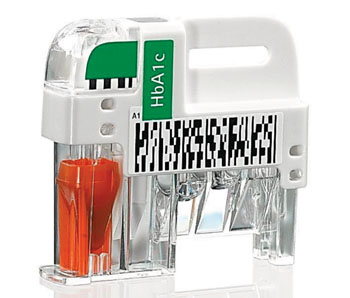Point-of-Care Diagnostic Test for Diabetes Reviewed
By LabMedica International staff writers
Posted on 31 Aug 2016
Supporters of point-of-care (POC) HbA1c testing emphasized its advantages, particularly the increased access it affords patients and the potential for more timely treatment changes that could improve glycemic control. Such tests also enable clinicians to discuss the results with patients before they leave the examination room, rather than requiring a follow-up visit.Posted on 31 Aug 2016
The system is identical to one already used to monitor patients with diabetes. That test has received a Clinical Laboratory Improvement Amendments (CLIA) waiver and can be used in numerous POC clinical settings with no required training. The US Food and Drug Administration (FDA, Silver Springs, MD, USA) typically convenes panels to provide a recommendation on approval. Although it is not required to follow the advice of such panels, it typically does.

Image: The Afinion HbA1c assay tests for quantitative determination of glycated Hemoglobin (HbA1c) in human whole blood (Photo courtesy of Alere).
In accuracy studies of the Alere Afinion HbA1c Dx, (Alere, Waltham, MA, USA) the total error estimates for the test based on venous whole blood precision estimates ranged from 2.25% to 3.16%, within the acceptance criterion for total error. The total error estimates for the test based on fingerstick whole blood ranged from 1.41% to 4.05%, also within the acceptance criterion of less than 6%. POC diabetes diagnostics is somewhat controversial. The American Diabetes Association (ADA) did not recommend such assays for diagnostic purposes in its 2016 guidelines, citing a lack of required proficiency testing. The missing support is the main reason the FDA asked for the panel review.
Robert E. Ratner, MD, the ADA chief scientific and medical officer, said, “Using the test to monitor patients already diagnosed with diabetes is appropriate because it doesn’t require the same degree of accuracy as a diagnostic test.” However, Richard Kahn, PhD, a clinical professor of medicine at the University of North Carolina in Chapel Hill, disputed that claim, arguing that POC testing could improve the diagnosis of diabetes (currently about a third of people with diabetes are undiagnosed) with little risk of false positives or negatives.
Related Links:
US Food and Drug Administration
Alere













